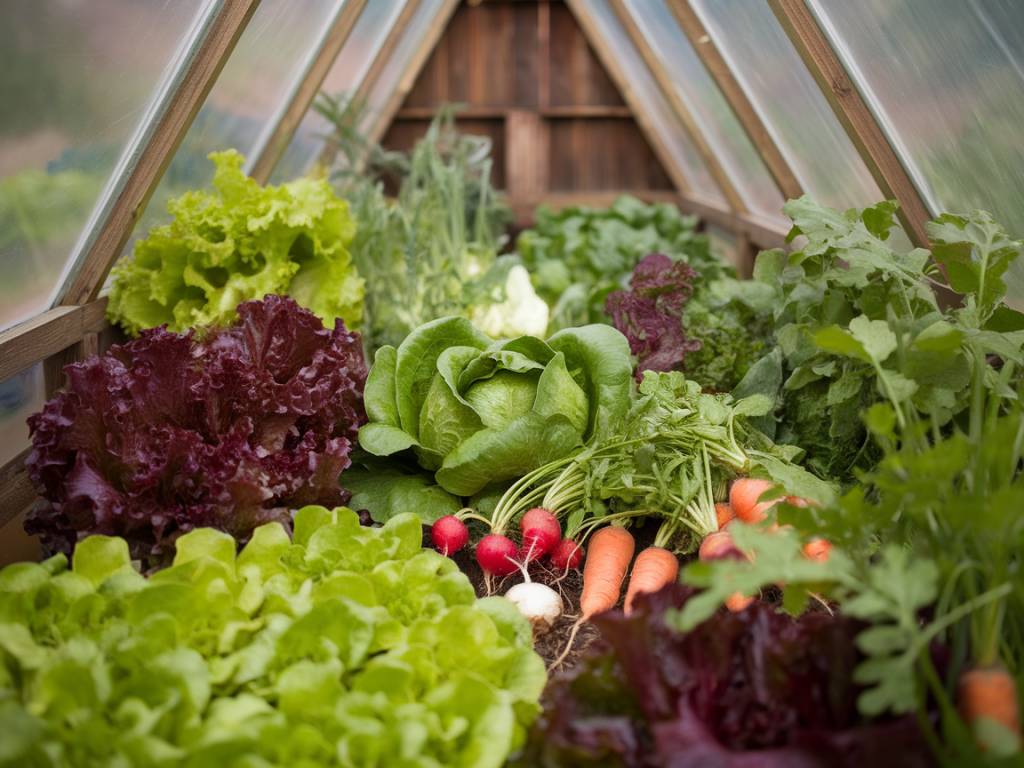As a passionate gardener who loves the joy of nurturing plants and watching them grow, I always strive to maximize the potential of my garden. Living in the UK, with our temperamental weather, a cold frame has become an invaluable asset in extending the growing season and protecting tender plants from the chill. For those keen on year-round gardening using natural methods inspired by permaculture, a cold frame can be a game-changer. Here are some of the best vegetables to grow in a cold frame.
Why Use a Cold Frame?
A cold frame is essentially a transparent, enclosed structure that protects plants from the harsh elements, allowing us to garden even in less-than-ideal conditions. It captures sunlight and retains heat, creating a microclimate that can be several degrees warmer than the surrounding air. This warmth can make a significant difference in our often cool and unpredictable weather.
Leafy Greens
Leafy greens are some of the easiest and most rewarding plants to grow in a cold frame. They thrive in cooler temperatures and can be harvested continually, providing a fresh supply of greens for your kitchen.
Spinach: Spinach is remarkably cold-tolerant and grows well in the cooler months. In a cold frame, it can be started early in the spring and grown late into the autumn.
Lettuce: Various types of lettuce, including romaine, butterhead, and leaf lettuce, flourish in a cold frame. They can be sown in succession for a continuous harvest.
Kale: This hardy leafy green thrives in cold weather. Curly kale, in particular, becomes sweeter after exposure to frost.
Swiss Chard: Swiss chard is hardy and can withstand light frost. It’s a fantastic option for the cold frame, offering both nutritional value and vibrant colours.
Root Vegetables
Root vegetables appreciate the protection a cold frame provides, allowing for extended growing periods.
Radishes: Radishes are quick to mature and can be harvested in a matter of weeks. Growing them in a cold frame means fresher, crisper radishes long into the colder months.
Carrots: Carrots can be a bit slow to start but thrive in the cool, protected environment of a cold frame. For the sweetest carrots, sow them in late summer and harvest through autumn and winter.
Beetroot: Beetroot can be sown towards the end of summer for an autumn harvest. They handle the cooler temperatures well and their greens are edible too.
Brassicas
The Brassica family includes some highly nutrient-rich vegetables that do exceptionally well in colder weather. A cold frame can help them get a strong start.
Cabbage: Early and late cabbage varieties benefit from the extra warmth and protection of a cold frame. They can survive light frosts and produce sweeter heads.
Broccoli: Broccoli is more cold-tolerant than many think. Starting them off in a cold frame ensures you’ll have strong, healthy plants ready for transplanting.
Cauliflower: Although a bit more finicky, cauliflower can be grown in a cold frame. It prefers cooler climates and can thrive if carefully monitored.
Herbs
Fresh herbs are a delight in the kitchen, and a cold frame can extend their growing season well into the colder months.
Parsley: Parsley is a surprisingly tough herb that can withstand some frost. Growing it in a cold frame keeps it productive for longer.
Cilantro (Coriander): This herb prefers cooler temperatures and bolted quickly in heat. A cold frame environment can extend its life and usability.
Chives: Chives are quite hardy and will keep growing in a cold frame, providing fresh, onion-flavoured garnishes almost year-round.
Thyme: More than just a culinary delight, thyme is a robust herb that can handle cold temperatures when protected by a cold frame.
Tips for Maximizing Cold Frame Success
Growing vegetables in a cold frame can be incredibly rewarding, but there are a few tips to ensure success:
Ventilation: Proper ventilation is crucial. On sunny days, even in winter, a cold frame can get quite warm. Opening the lid a bit will prevent overheating and provide fresh air.
Temperature Monitoring: A simple thermometer can help you keep track of the temperatures inside the cold frame and ensure that conditions remain optimal for plant growth.
Succession Planting: Plan your plantings in succession so that you can continuously harvest throughout the season. This ensures a steady supply of fresh vegetables.
Mulching: Using mulch can help retain soil moisture and provide additional insulation against temperature fluctuations.
Watering: Regular watering is essential, but be careful not to overwater. Cold frames can sometimes create humid environments which could lead to mould and mildew.
Earnings from gardening are not merely measured in the vegetables grown, but in the satisfaction of nurturing a connection with nature. Using a cold frame allows me to continue this connection throughout the year, embracing the seasons and the fresh produce each one offers. I hope these tips and suggestions inspire you to make the most of your cold frame and enjoy a bountiful harvest. Happy gardening!
With green thumbs,
Samanta






